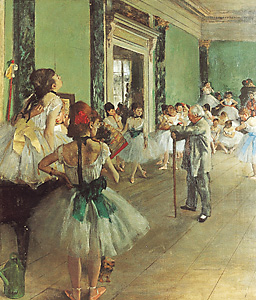Degas at the Opéra
Monday, March 2nd, 2020March 2, 2020
Yesterday, March 1, an exhibition on the French impressionist painter Edgar Degas opened at the National Gallery of Art (NGA) in Washington, D.C. The exhibition, called “Degas at the Opéra,” celebrates the artists’ many works set in the Paris Opéra. The exhibition includes about 100 of the artist’s most famous paintings, pastels, drawings, prints, and sculptures. “Degas at the Opéra” runs until July 5. Prior to its run at the NGA, the exhibition had been at the Musée d’Orsay in Paris since September 2019, shortly after the Opéra celebrated the 350th anniversary of its founding in 1669.

The Dancing Class by Edgar Degas
credit: The Dance Class 1874 by Edgar Degas. Oil on canvas/The Granger Collection
Like the other impressionists, Degas portrayed situations from modern life. However, he did not share his fellow impressionists’ concentration on light and color. Degas emphasized composition, drawing, and form more than did the other members of the movement. He is best known for his paintings of people in both public and unguarded private moments. He showed his figures in awkward or informal positions to free himself from what he felt were outmoded styles of portraying the human body. But, he composed his pictures carefully both for formal balance and to indicate the social interaction of his figures.
Hilaire Germain Edgar Degas was born on July 19, 1834, in Paris, of wealthy parents. From 1854 to 1859, he spent much time in Italy studying the great Renaissance painters to perfect his draftsmanship and style. Degas intended to become a painter of historical scenes, but he abandoned this career because he felt a need to paint modern subjects. Probably under the influence of the painters Gustave Courbet and Édouard Manet, Degas began to paint scenes from everyday life. He especially enjoyed painting pictures of race-track and theatrical life. Degas painted many pictures in oil, but he also excelled in pastel. In addition, he was a fine sculptor and made many clay or wax figurines. Degas died on Sept. 27, 1917.


